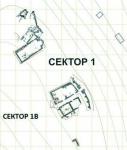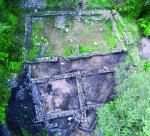Summary (English)
SHISHMANOVO KALE FORTRESS (Veselin Hadzhiangelov – vhajiangelov@yahoo.com) The archaeological explorations were resumed. A fortification gate 2.90 m wide was discovered, built of roughly-cut stones and boulders bonded with mortar. The road from the gate led towards the church located on the neighboring hill. The gate was closed with a two-wing door and its two stone axles were found. The southern door axle was a spolia (reused column). The fortification wall was 1 m wide, reinforced with pilasters that supported a wooden platform from the inner side of the wall. Building No. 2 consisting of parallel rooms arranged in a line was discovered close to Building No. 1. There was a street c. 2 m wide between both buildings, which started from the postern in the fortification wall. Two rooms were explored in Building No. 2 and a third one was partly discovered. The average width of the walls was 65 cm, built of boulders and roughly-cut stones bonded with clay. The entrances of the two rooms towards the street, c. 90 cm wide, were discovered. The rooms were used for storage and cooking: dug outs for dolia were discovered in both rooms and three domestic ovens were explored in the second one. Building No. 2 had a second floor, judging from the outer staircase that was discovered. The building had glass windows and its rood was covered with tegulae and imbrices. Building No. 3 with identical features was discovered. Judging from the coins, the buildings dated to the 4th – first half of the 5th centuries AD. Several coins of the middle of the 3rd century AD and an anonymous Byzantine follis of the middle of the 11th century were also found.
- Veselin Hadzhiangelov - Museum of History – Samokov
Director
Team
Research Body
- Museum of History – Samokov






![Download [PDF]](/excavation/skins/fasti/images/results/download_sml.png)
